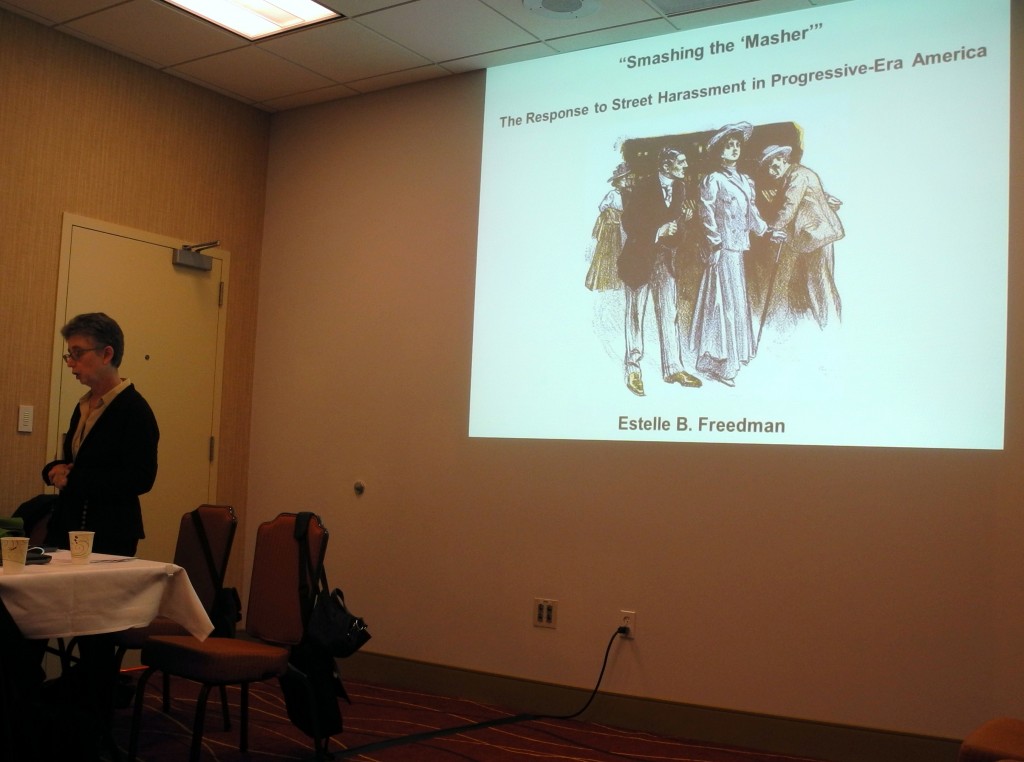
I was so thrilled to meet Stanford University Professor Estelle Freedman last year at the National Women’s Studies Association Conference and hear her presentation about street harassment in history, the focus of a chapter in her book Redefining Rape: Sexual Violence in the Era of Suffrage and Segregation.
I promised not to publicly share very much about what I learned then until her book was released last month, and now the time has come!
These are really interesting tidbits from her talk that I want to share —
* In the 19th century, “Mash” was a crush. A masher may write a love letter. On stage, actresses were the objects of mashers. Then mashers became a description for men who have affairs and/or men who imagined themselves “ladykillers” or “Don Juans.” Men who went to brothels might also be called mashers.
* In the mid to late 1800s, women who were in public unescorted were seen as “public women” aka prostitutes. They were seen as “fair game” by men on the streets.
* As more poor and middle class women entered public spaces unaccompanied by a man to go to work or to go shopping or to the movies, the mashers were seen as a problem because they “flirted” with women, invite them, ingratiate themselves to them, and touch them at a theater.
* Newspapers started talking about the need to protect women from mashers (by other men) and there was advice given to women about looking serious, having a mantle of reserve, etc to deter men from approaching them.
* The mashers were largely white middle class men, in contrast to the “sexual predator” of black men. When black men were in the news, it was generally for rape, contributing to the idea that they were worse sexual predators than white men. Lynching of black men covered in papers in contrast to not doing much about white mashers or rapists.
* In early 1900s, we started to see more information about women who fought back – “thrashing the street mashers.” There is a shift from the need to protect women to women being self-reliant.
* In 1905-06 there were a series of murders of white women in Chicago, which led to a panic over protecting women. There was a crack down on men loitering on the streets and more police officers. Some women rejected male protection and said they need political rights to advocate for themselves. They become subjects versus objects in the conversation.
* 1905, a Philadelphia stenographer took boxing lessons from her brother and knocked out a masher. She advocated for other women to do the same and advocated for the Society for the Suppression of the Masher.
* There were women who advocated for women to exercise and get strong so they could resist street harassment.
* In 1914, a niece (by marriage) of the president of the USA was so fed up with being harassed that she said she’d send the next man who harassed her to jail. The next man was a Dr. and he went to jail for 10 days.
* By 1916, there were 300 female police officers across the country: mostly white but some black women in cities. Addressing complaints of mashers was often one of their purposes.
* After WWI, there was a more benign image of the masher, in part because of more relaxed views on courtship and dating. By the 1925 there was a stall of recruitment of female police officers because people were balking at the idea of undercover women arresting men who “flirted” with them on the streets.
* “Ofay Mashers” were white men who harassed black women. The Black Press drew a lot of attention to the street harassment and rape of black women by white men. Men often solicited women, assuming they were prostitutes [still happens today] and would walk through the neighborhoods approaching women, or, later, drove through the neighborhoods and pulled over to harass. Not much is available about black men harassing black women – perhaps it didn’t happen much or there was racial solidarity that kept women from speaking out when it happened.
* As more women wanted to be in public spaces alone, mashers were seen as a real problem. However, after a few decades, the fears of mashers gave way to acceptance of it as flirting.
* Today, as then, we have a common goal of contesting male privilege/access to public spaces through speaking out against street harassment.
Also, check out Part 1 and Part 2 of my review of her book and interview with her about the chapter on street harassers.
After hearing her talk, my domestic partner Mark and I have done several hours of research at local universities on street harassment in history. I hope to create an online exhibit and timeline in 2014. Stay tuned.

Lauren says
Hello! Did you visit any universities that had collections dealing with street harassment from the 1880s-1920s?